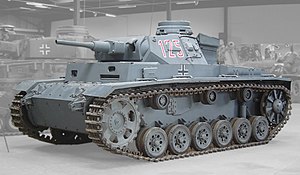Panzer III
| Panzerkampfwagen III | |
|---|---|

Panzer III Ausf. H (auf Ausf. H Fahrgestell). Musée des Blindés, France (2006)
|
|
| Type | Medium tank |
| Place of origin | Nazi Germany |
| Service history | |
| In service | 1939–1945 |
| Used by |
Nazi Germany Kingdom of Romania Slovak Republic Kingdom of Hungary Independent State of Croatia Turkey Norway |
| Wars | World War II |
| Production history | |
| Designer | Daimler-Benz |
| Designed | 1935–1937 |
| Manufacturer | Daimler-Benz |
| Produced | 1939–1943 |
| Number built | 5,774 (excluding StuG III) |
| Specifications | |
| Weight | 23.0 tonnes (25.4 short tons) |
| Length | 5.56 m (18 ft 3 in) |
| Width | 2.90 m (9 ft 6 in) |
| Height | 2.5 m (8 ft 2 in) |
| Crew | 5 (commander, gunner, loader, driver, radio operator/bow machine-gunner) |
|
|
|
| Armour |
Ausf A-C: 15 mm all around Ausf D-G: 30 mm all around Ausf J+: 50 mm all around |
|
Main
armament |
1 × 3.7 cm KwK 36 Ausf. A-F 1 × 5 cm KwK 38 Ausf. F-J 1 × 5 cm KwK 39 Ausf. J¹-M 1 × 7.5 cm KwK 37 Ausf. N |
|
Secondary
armament |
2–3 × 7.92 mm Maschinengewehr 34 |
| Engine | 12-cylinder Maybach HL 120 TRM 300 PS (296 hp, 220 kW) |
| Power/weight | 12 hp (9.6 kW) / tonne |
| Suspension | Torsion-bar suspension |
|
Operational
range |
165 km (103 mi) |
| Speed | Road: 40 km/h (25 mph) Off-road: 20 km/h (12 mph) |
The Panzerkampfwagen III, commonly known as the Panzer III, was a medium tank developed in the 1930s by Germany, and was used extensively in World War II. The official German ordnance designation was Sd.Kfz. 141. It was intended to fight other armoured fighting vehicles and serve alongside and support the Panzer IV; however, as the Germans faced the formidable T-34, more powerful anti-tank guns were needed, and since the Panzer IV had more development potential, it was redesigned to mount the long-barrelled 7.5 cm KwK 40 gun. The Panzer III effectively became obsolete in this role and was supplanted by the Panzer IV. From 1942, the last version of Panzer III mounted the 7.5 cm KwK 37 L/24, better suited for infantry support. Production of the Panzer III ended in 1943. However, the Panzer III's capable chassis provided hulls for the Sturmgeschütz III assault gun until the end of the war.
At the time, German (non-light) tanks were expected to carry out one of two primary tasks when assisting infantry in breakthroughs, and exploit gaps in the enemy lines where opposition had been removed, moving through and attacking the enemy's unprotected lines of communication and the rear areas. The first task was direct combat against other tanks and other armoured vehicles, requiring the tank to fire armour piercing (AP) shells. On January 11, 1934, following specifications laid down by Heinz Guderian, the Army Weapons Department drew up plans for a medium tank with a maximum weight of 24,000 kg (53,000 lb) and a top speed of 35 km/h (22 mph). It was intended as the main tank of the German Panzer divisions, capable of engaging and destroying opposing tank forces, and was to be paired with the Panzer IV, which was to fulfil the second use: dealing with anti-tank guns and infantry strong points, such as machine-gun nests, firing high-explosive shells at such soft targets. Such supportive tanks designed to operate with friendly infantry against the enemy generally were heavier and carried more armour.
...
Wikipedia
